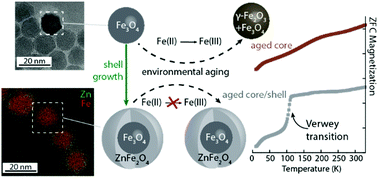Shell-mediated control of surface chemistry of highly stoichiometric magnetite nanoparticles†
Abstract
Magnetite (Fe3O4) nanoparticles are one of the most studied nanomaterials for different nanotechnological and biomedical applications. However, Fe3O4 nanomaterials gradually oxidize to maghemite (γ-Fe2O3) under conventional environmental conditions leading to changes in their functional properties that determine their performance in many applications. Here we propose a novel strategy to control the surface chemistry of monodisperse 12 nm magnetite nanoparticles by means of a 3 nm-thick Zn-ferrite epitaxial coating in core/shell nanostructures. We have carried out a combined Mössbauer spectroscopy, dc magnetometry, X-ray photoelectron spectroscopy and spatially resolved electron energy loss spectroscopy study on iron oxide and Fe3O4/Zn0.6Fe2.4O4 core/shell nanoparticles aged under ambient conditions for 6 months. Our results reveal that while the aged iron oxide nanoparticles consist of a mixture of γ-Fe2O3 and Fe3O4, the Zn-ferrite-coating preserves a highly stoichiometric Fe3O4 core. Therefore, the aged core/shell nanoparticles present a sharp Verwey transition, an increased saturation magnetization and the possibility of tuning the effective anisotropy through exchange-coupling at the core/shell interface. The inhibition of the oxidation of the Fe3O4 cores can be accounted for in terms of the chemical nature of the shell layer and an epitaxial crystal symmetry matching between the core and the shell.



 Please wait while we load your content...
Please wait while we load your content...
